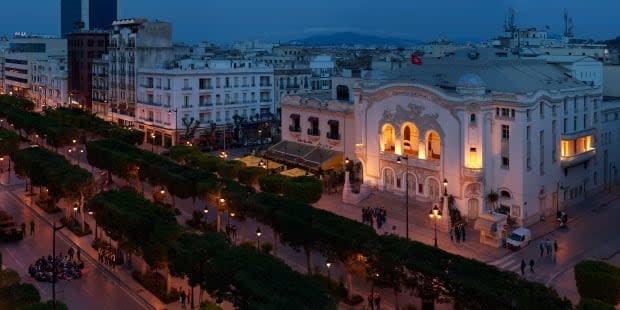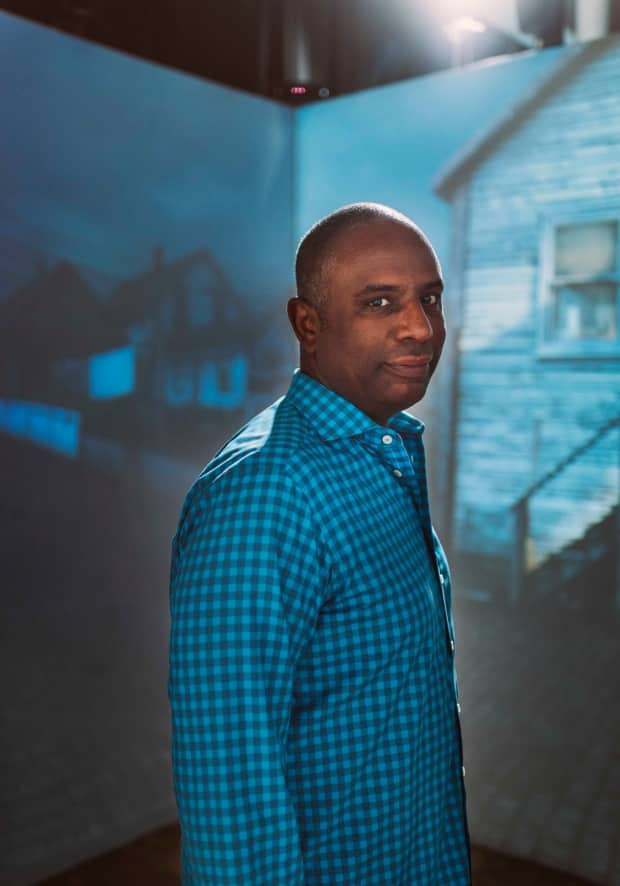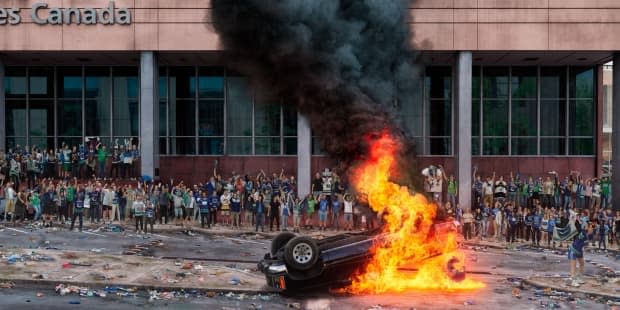Stan Douglas is Canada's artist at Venice Biennale but bristles at notion of 'representing Canada'

At first glance, the four huge photographs of protests by Vancouver artist Stan Douglas displayed in the small, angular Canadian pavilion of the Venice Art Biennale look like reportage.
There's an aerial view of the Tottenham riots in the U.K., with smoke, scattered protesters and police flanks; a scene of Occupy Wall Street in New York with non-violent resisters being arrested; clusters of young people gathered on the main avenue in Tunis, Tunisia, peacefully discussing politics and an alternate future at the onset of the Arab Spring; and the Vancouver riots after the Canucks were defeated in the Stanley Cup finals, with a crowd of hockey fans cheering an overturned car that has been set ablaze.
Yet on closer examination, the viewer notices every single person, object and structure captured by the camera is in perfect focus and fully rendered.
These images are not photojournalism at all, but elaborately produced reimaginings of real events, all of which took place in 2011.

"It's the idea of poetic condensation," said Douglas, one of Canada's most internationally acclaimed artists, "of having as much information in one place to allow the viewer to see it and parse it as they need to. It has a sense of unreality.
"But I'm not trying to fool anybody. I'm saying this construction is less a snapshot of the moment, but more a schematic or diagram of a riot."

He calls this form "hybrid documentaries."
The two-part show — the photographic series 2011 ≠ 1848 and the video installation ISDN, in another part of Venice — marks Douglas's fifth appearance at the Venice Art Biennale, perhaps the most prestigious art exhibition in the world.
But it's his first show as Canada's officially selected artist, and the first time Canada has chosen a Black artist.
The virality of protest
In 2011 ≠ 1848, Douglas links the protests of 2011 to the widespread upheaval of the 1848 "Springtime of Nations," when bourgeois uprisings against the aristocracy erupted across Europe.
Douglas is interested in the similarities between the two years — the 1848 protests spread with the help of print technology, whereas the 2011 blew up thanks to social media.

"Many of the events you see depicted were made larger by people saying, 'This is going on. Come down.' The example of the Arab Spring is what inspired Occupy Wall Street," he said.
But there are key differences: 1848 ultimately led to the formation of nation-states, whereas the social inequality that fomented the 2011 protests — a ripple effect of the Great Recession from 2007 to 2009 — remains depressingly unresolved, he says.
Other events since then, including the COVID-19 pandemic and Black Lives Matter, have shone more light on the underlying social inequality.
The second part of Douglas's show, ISDN, is set just before 2011, as the use of the digital transmission system to transmit audio over traditional phone lines began to decline, and is more hopeful.
Two giant screens hang in a disused 16th-century salt warehouse with U.K. grime musicians projected on one and Mahraganat artists (who fuse hip hop, electronica and Egyptian folk music) on the other.
The two groups of rappers seem to perform an endless call-and-response, but it's fictitious, as they were each recorded separately, without listening to the other.
WATCH | U.K. and Egyptian rappers collaborate in Stan Douglas's video installation ISDN:
The result is a joyful session of imaginary collaboration, with bass lines, drums, melodies and effects tracks all on different time loops creating an "improvised" jam that lasts more than three days before repeating in the same order.
"They both took the model of U.S. hip hop … but then incorporated a local idiom with that," said Douglas of the U.K. and Egyptian music. "In the piece, a third idiom comes out of that through [the imaginary ISDN] collaboration. Your mind makes connections where there may not be any."
Sign of 'incredible maturity'
Douglas, 61, studied at the Emily Carr University of Art and Design in Vancouver and now spends half his time in L.A., where he's chair of the graduate program at the ArtCenter College of Design.
He has spent a career making photographs, film and most recently theatre exploring failed utopias and alternative histories as they relate to urbanism, technology and post-colonialism.
He uses elaborate techniques for his photographs. Shoots can last days, in which dozens of actors are photographed on a soundstage, sometimes one at a time, and then composited together with a digital plate shot of the location.
Douglas has a strong fanbase both in the world of art and film.
"It's interesting to look at world history through four photos and [process] all that happened and what became of it," said German art curator Bettina Steinbruegge, referring to 2011 ≠ 1848.

"And then you see the rap musicians, which is very political and a younger generation. It's a good way to look at what's happening, all the turmoil. We are living in a world that is changing rapidly and is quite aggressive, and I think he captured it very well."
Mark Peranson, publisher of the Canadian film magazine Cinema Scope, is equally enthusiastic.
"The way he composes the video stylistically with the reiterations of the algorithm works really well with rap music," he said. "Because there's not a strict narrative [with rap], it worked. And the music is great."
Reid Shier, the curator of the Canada pavilion in Venice and part of the three-person committee through the National Gallery of Canada that selected Douglas to represent Canada, calls him an incredibly generous and accessible artist.
"If you walk into ISDN and don't know anything about Stan Douglas or contemporary art, you're going to be met with a work that is about an experience of listening to music in real time," he said. "It's not something you have to come in and read like a long, didactic panel to understand. You can get it visually, sensorially, audially, in so many different ways, and that's incredible maturity."
'International interconnectedness'
While race is a consistent element in Douglas's work, it's not explicitly autobiographical and usually part of a larger exploration of post-colonialism.
His 1991 short, I'm Not Gary, features a white man mistakenly calling a Black man he passes on the street Gary, a commentary on racial invisibility. In Inconsolable Memories (2005), Douglas reflects the experience of a Black, working-class Cuban.

He says he's had an abiding interest in race, but has resisted showing it from a purely regional perspective, citing another early work, Der Sandmann (1995), which features an African German character whose experience is closer to his own.
He's "kind of an outsider figure," which is similar to Douglas's experience "growing up in Vancouver with a majority-white population."
Douglas says this year's Venice show has been the most fun so far — he's been here enough to know what to expect, and to be able to relax. But he bristles at the idea of "representing Canada" as the country's official artist this time around.
"I have a problem with the idea of identity, so in representing Canada, I'm not representing Canada — I'm representing international interconnectedness," he said, a point made in his work.
"I identify as Canadian, but I don't want to say, 'This is what Canada is.' I have no idea of what that is. To produce a national myth about what Canada is, is not really feasible. Unlike the U.S., that's all held together by people who can't stand each other but who love their constitution, their revolution or whatever it was. In Canada, we don't have those unifying myths."

While Canada may not have unifying myths, one could argue it has a certain unifying mode of expression that, even in the big-ego world of contemporary art, shuns hyperbole and self-aggrandizement.
When asked if he's surprised about how well his career as an artist has gone, Douglas laughs.
"Oh yeah, I never thought I would not have to have a job," he said. "When I was coming up, the expectation of having [an art] career was very low, especially as a Canadian."
He pauses, then gives an understated — one could say quintessentially Canadian — explanation for his success.
"Lucky. Right place, right time."
